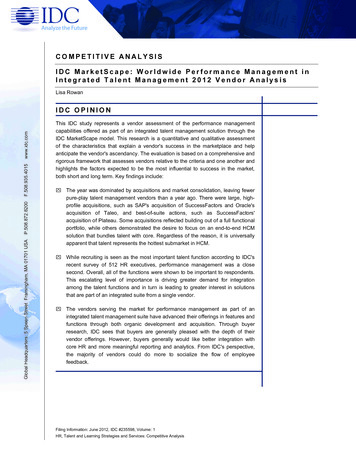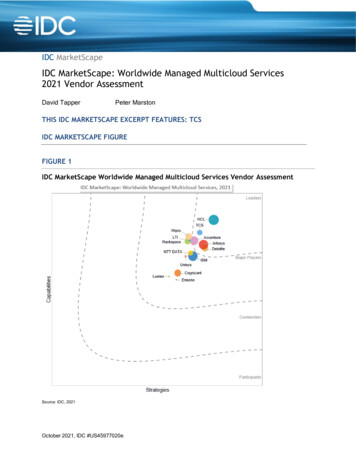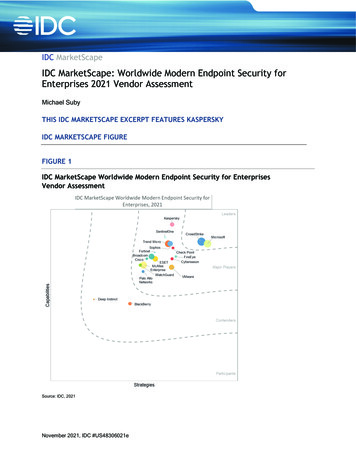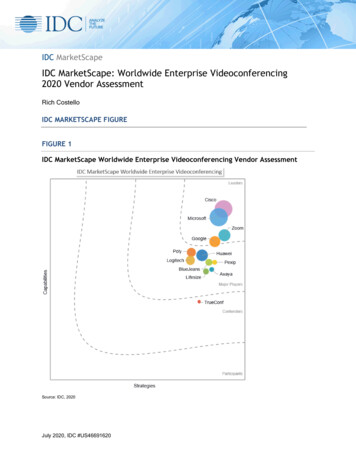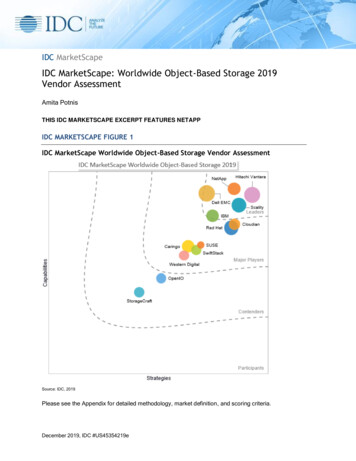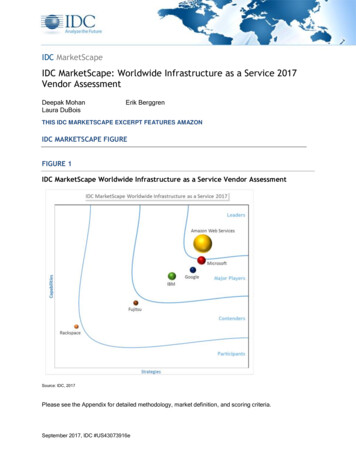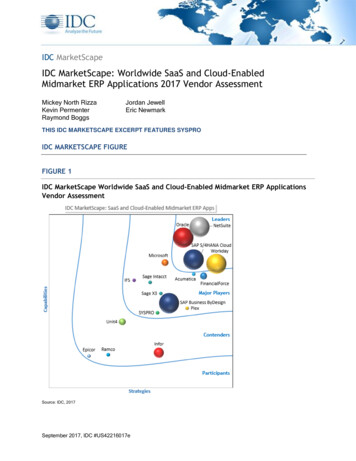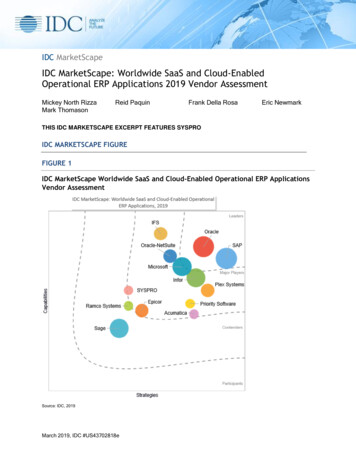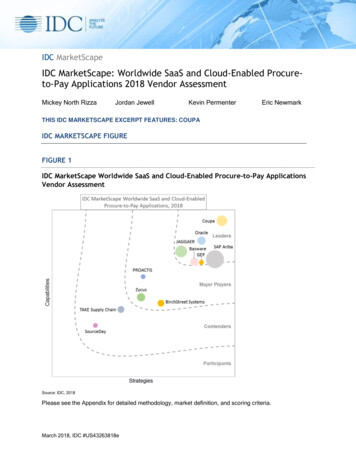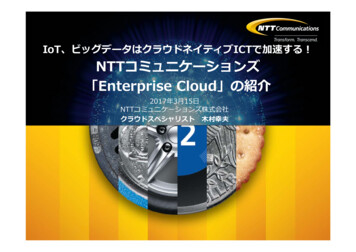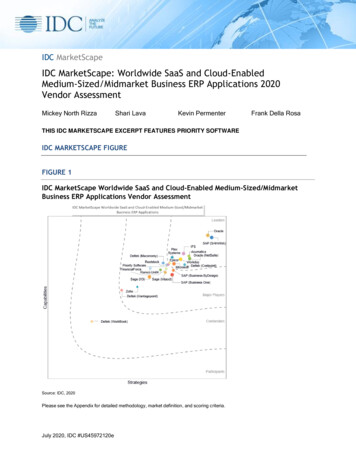
Transcription
IDC MarketScapeIDC MarketScape: Worldwide SaaS and Cloud-EnabledMedium-Sized/Midmarket Business ERP Applications 2020Vendor AssessmentMickey North RizzaShari LavaKevin PermenterFrank Della RosaTHIS IDC MARKETSCAPE EXCERPT FEATURES PRIORITY SOFTWAREIDC MARKETSCAPE FIGUREFIGURE 1IDC MarketScape Worldwide SaaS and Cloud-Enabled Medium-Sized/MidmarketBusiness ERP Applications Vendor AssessmentSource: IDC, 2020Please see the Appendix for detailed methodology, market definition, and scoring criteria.July 2020, IDC #US45972120e
IN THIS EXCERPTThe content for this excerpt was taken directly from IDC MarketScape: Worldwide SaaS and CloudEnabled Medium-Sized/Midmarket Business ERP Applications 2020 Vendor Assessment (Doc # #US45972120). All or parts of the following sections are included in this excerpt: IDC Opinion, IDCMarketScape Vendor Inclusion Criteria, Essential Guidance, Vendor Summary Profile, Appendix andLearn More. Also included is Figure 1.IDC OPINIONMedium-sized/midmarket enterprise resource planning (ERP) application vendors have made greatstrides over the past year, increasing the visibility, transparency, intelligence, and innovation offinancial, procurement, inventory, manufacturing, supply chain, and services business processes. As aresult, organizations are more agile than in previous years, enabling the organization to be moreresilient. This resilience is a required during the COVID-19 pandemic and will be even more so in apost-COVID-19 world. Organizations are now making difficult but necessary choices for both near- andlonger-term survival. Business survival has become dependent on having a constant up-to-date viewof the state of the business, which includes having the right modern ERP solutions that can be utilizedanywhere and anytime as well as help the business navigate the journey through turbulent times andaccelerated growth.The Digital World Requires Modern TechnologyThe digital world has arrived. The COVID-19 pandemic became the tipping point for businesses torethink their entire business as a digital organization. From fulfilling orders digitally and physically toremote working by employees, businesses have found they need cloud and software-as-a-service(SaaS) software to run their businesses effectively. It is important to note that there are many trends inmodern ERP technology that can assist the buyer in the selection process: Evolving business models: Subscription-based business models are set to grow rapidly in thecoming years in nearly every sector. However, the greatest challenge for financial applicationscomes from the rapid rise of mixed/hybrid business models (i.e., traditional and subscriptionbased). More and more, companies are operating mixed business models that offer bothproducts and services in a traditional model as well as a recurring model. For example, aSaaS software vendor (e.g., Red Hat or Adobe) may also sell professional services/consulting.Lately, some of the larger consulting companies (e.g., EY and Deloitte) are offering softwareapplications in addition to their consulting services. Many hardware companies (e.g., Appleand Nest) are offering software solutions that run on top of their hardware. The buyer must askthe right questions to understand what is being purchased. Changing deployment models: ERP application vendors are investing more and moreresources to build out the business functionality of their cloud software. This includesinvestment in infrastructure functionalities such as databases, service-level agreements(SLAs), and microservices. ERP application vendors are also working diligently to supporttheir sales teams and implementation partners with customer evaluation tools to facilitate thetransition to the cloud. Convergence of workflows: The traditionally siloed nature of the operational functions such asprocurement, inventory, manufacturing, customer project management, and the various areasof finance is rapidly changing. The walls are finally starting to break down, necessary for morecoordination, collaboration, and communication among these and other functions. As such, 2020 IDC#US45972120e2
decision makers will have a much more holistic view of the company's performance at all timesso that better strategic decisions can be made. Emergence of digital business: As organizations move into the digital economy, focused ondigital transformation initiatives, they are turning to advanced technologies to enable theirevolution. Fueled by the enormous amount of waste and inefficiency within the operations, theorganization requires more advanced and innovative technology. Vendors are supportingdigital transformation with new use cases that ERP applications leverage, with technologiessuch as big data and analytics and machine learning (ML) to bring more actionable insightsacross a broader workstream.The digital world has enabled a new reality. It will be the companies with the right mix of talentand software tools that will be best able to recover and thrive in these changing conditions.ERP vendors that prioritize features that provide/enhance visibility, flexibility, and agility willfind themselves well positioned for future growth.The Midmarket DilemmaMidmarket companies (firms with 100–999 employees in North America and Japan and firms with 100–499 employees in the rest of the world) have a unique dilemma. They have much of the complexity oflarger enterprise businesses as many of them are selling products and services globally; midmarketcompanies encounter all the same issues related to global complexity (i.e., currency issues,localization issues, shifting customs, transfers of goods and services, and tax regulations). However,midmarket companies are often forced to cope with these issues with fewer resources than largerbusinesses while navigating the growing organizational complexity that comes with a growingbusiness. This dilemma drives midmarket companies toward capabilities that are critical to theirbusiness needs. As a result, midmarket companies have developed a core set of requirements as itrelates to their ERP software: More focus on vertical markets: Many midmarket companies tend to specialize in serving onecustomer group, often coalescing around a vertical (professional services, manufacturing, notfor profit, etc.). These midmarket companies are looking for ERP applications with a deepreservoir of functionality related to their chosen vertical market. While certain businessprocesses are common among all industries, there are industries such as higher education,healthcare/pharma, government, manufacturing, nonprofit, or service organizations wherebusiness processes and reporting requirements differ greatly. More emphasis on ecosystem: Midmarket businesses often use a partnering strategy to drivegrowth. This often means more complicated transactions and partner interactions. This placesgreater emphasis on the financial, project, and industry-unique workflows. A partneringstrategy places more emphasis on the software's capability to connect to other point solutions— both internal and external, this is typically a top priority for midmarket businesses that havean established and entrenched set of applications. As a result, it is essential for midmarketERP vendors to provide robust APIs to streamline the data flow between systems. Better user experience (UX): User experience has become a major point of differentiation formidmarket software purchases. Simpler and easy-to-use user interfaces (UIs), moreconfiguration/flexibility, mobile functionality, increased automation, and even implementationprocesses will factor into the overall user experience with the software. Want a trusted brand: IDC's most recent SaaSPath Survey of over 2,000 survey respondentsrevealed that organizations purchasing ERP applications find the most important attributewhen evaluating ERP technology vendors is a trusted brand. Every ERP technology vendorhas different products, functionality, deployment models, and innovation. While some are more 2020 IDC#US45972120e3
innovative, others are focused on a subset of industries and still others are better in terms ofservices functionality versus manufacturing and supply chain specialties. Regardless the trustcomes from transparency, building out new innovative solutions together, providingexceptional value beyond the sales cycle, and helping the business navigate the challengesthat arise. Superior features and functionality: In addition to a trusted brand, IDC's recent SaaSPathSurvey of over 2,000 survey respondents revealed that organizations purchasing ERPapplications find the second most important attribute when evaluating ERP technologyvendors is superior features and functionality. Organizations need to know they haveexceptional business processes that have intelligence embedded into them to reduce lowerlevel tasks. Predictive analytics aids the organization as it models business outcomes, so thebest action can be selected. And organizations want to know Internet of Things (IoT), drones,robotics, AR/VR, and other innovative aspects can be integrated quickly and easily into theirsolution. More agility through collaboration: Agility is core for midmarket companies as it is often one oftheir most reliable advantages over larger competitors. A large portion of that agility comesfrom collaboration capabilities. Companies are utilizing real-time collaboration aspects of moremodern cloud-based ERP software solutions to share access to critical sales and operationaldata with teammates. With this technology-driven collaboration in place, companies can moreeffectively respond to market changes quickly — essential for a midmarket company competingwith larger firms. Demand for greater process controls: In contrast to smaller companies, midmarket companiesare large enough to have more dedicated job roles and formal departments. As a result, manyof them are looking for a full suite of process workflows and process controls. The ability totailor the employee's user interface to only necessary information is critically important formidmarket companies.The ERP software market for midmarket companies is attracting much attention from industrycompetitors and industry investors. As a result, software vendors are quickly trying to develop the rightblend of functionality, pricing, and customer support to be profitable and to thrive within the midmarket.This strategy also helps the vendors stay with the organization as it grows into a larger enterprise.IDC MARKETSCAPE VENDOR INCLUSION CRITERIAThe vendor inclusion list for this document was selected to accurately depict the vendors that are mostrepresentative of the ERP functional buyer's selection list based on the following: Vendors were investigated to ensure that their offerings were qualified as "SaaS" or "cloudenabled" and that the vendor had won recent deals within the relevant customer segment. ERP software must meet the IDC definition of ERP. Vendors had either product- or services-specific ERP focus — or a combination of both. Incoming IDC inquiries are related to midmarket ERP solutions, with specific questionsfocused on capabilities of vendors, innovation and future trends of ERP vendors, andcustomer interviews. Vendors were asked to name other vendors they most often compete against in deals. 2020 IDC#US45972120e4
ADVICE FOR TECHNOLOGY BUYERSAs a medium-sized business, choosing an ERP system that can grow with your business can be adaunting task. There is a stunning amount of variety and hundreds of options among softwarepackages specifically targeting midmarket businesses. Following are a few key steps in the journey toselect the right fit among the myriad of software vendors: Understand your needs: Before you choose your ERP vendor and product, you should firsttake the opportunity to do some self-reflection. A few key questions to ask regarding theinternal factors involved in choosing software are: What is the plan for growing the business? How has the COVID-19 pandemic changed or restructured the business? What features do I consider essential for the business now and in the future? Are there industry-specific considerations for software selection? Are there new innovations that will make my employees work life easier and morebalanced? How many users will interact with the software within the business? How will we use IT to support the business? How much am I willing to spend on the software? How defined are my processes, or am I looking to improve them by leveraging bestpractice processes?Do your research: With so many options, medium-sized business owners must take asystematic approach researching and vetting these software packages. Medium-sizedbusiness owners should consider tapping into the vast web of software evaluation optionsincluding market research firms, online review sites, and industry associations. A few keyquestions to ask when researching the software are: Does the software come with a free trial? How do I buy the software? Can it be downloaded, or can I just get started online? Whom can I consult with on this matter? My team? Other business owners? Investors? How long does it take to implement the software? How quickly can I start using the product? Does the software have positive reviews? What level of customer service is offered? Do I need an outside consultant to help me install the software and bring it to use? Is thereself-training available for our team? What type of in-house IT resources do I need to have available, if any?Look to the future: Many midmarket businesses may find themselves growing rapidly. In thesecases, the software must be able to grow with your business and ideally help reduce thenumber of applications used to manage the business. And in the case of a pandemic, abusiness may need to slow down too, so organizational agility is critical when purchasingsoftware. A few key questions to ask when considering the growth aspect of choosing asoftware package are: What factors will speed up or slow down my growth plans? How fast will the business likely grow? If my business slows or stalls, how do I curtail my usage costs? 2020 IDC#US45972120e5
Will the business be selling to/interacting with businesses/customers in other regions orcountries? What kinds of reporting and insights will I need to manage the business as I grow? Canthe software provide it? Does the software vendor have innovation aspects that will make my business runsmoother? What does the software vendor's road map look like for this product? What is the software vendor's financial viability for the long haul? Will I add subordinate business units/divisions/franchises?This IDC MarketScape vendor assessment assists in answering the aforementioned questions andothers. The goal of this document is to provide potential software customers with a list of mediumsized business ERP software companies that have taken great strides to incorporate the previouslylisted capabilities. We have profiled and assessed their capabilities to support the complicated area ofERP software.VENDOR SUMMARY PROFILEThis section briefly explains IDC's key observations resulting in a vendor's position in the IDCMarketScape. While every vendor is evaluated against each of the criteria outlined in the Appendix,the description here provides a summary of the vendor's strengths and challenges.Priority SoftwareAfter a thorough evaluation of Priority Software's strategies and capabilities, IDC has positioned thecompany in the Major Players category in this 2020 IDC MarketScape for the worldwide SaaS andcloud-enabled medium-sized/midmarket business ERP applications market.Priority Software is headquartered in Israel, with offices in the United States, the United Kingdom, andBelgium, and it offers full, comprehensive cloud (full SaaS) and on-premises ERP solutions. Priority'ssystem is based on an open, flexible, scalable, multilanguage, and multicurrency platform that can beeasily customized. Priority also has functionality in a wide range of areas — finance, purchasing,manufacturing, HR, project management, customer service, CRM, and sales. Quick facts about PrioritySoftware include: Employees: 225 Total number of clients: 10,000 ERP customers, with 2,700 on the cloud version Globalization: Customers in 10 languages in 16 countries Industry focus: Discrete and process manufacturing across all industry types SaaS: Offered in a multitenant deployment at the application, database, and cloudinfrastructure layers Pricing model: Subscription based by modules consumed and the number of users Partner ecosystem: Over 60 authorized Priority business partner companiesStrengths Simplified SMB: Priority Software believes in simplification and has designed intuitive screensfor small and medium-sized businesses to get the most from their ERP system. 2020 IDC#US45972120e6
Agility: References noted that the system is extremely easy to use and agile. Customer satisfaction: Organizations like working with this friendly and overly accommodatingteam of employees.Challenges Intelligent workflows: Priority Software is focused on an integrated rules-based generation forintelligent workflows. Machine learning has not yet been applied to the workflows. Product road map: References noted the road map could be communicated more often.Priority Software does release new software versions twice a year. Financial workflows: References noted the product is good, but while all U.S. tax and reportingregulations are fully supported, further adjustments could be implemented to support regionalbest practice U.S. standards in the financial workflows.Consider Priority Software WhenConsider Priority Software when you are a midsize manufacturer looking for a SaaS ERP solution.APPENDIXReading an IDC MarketScape GraphFor the purposes of this analysis, IDC divided potential key measures for success into two primarycategories: capabilities and strategies.Positioning on the y-axis reflects the vendor's current capabilities and menu of services and how wellaligned the vendor is to customer needs. The capabilities category focuses on the capabilities of thecompany and product today, here and now. Under this category, IDC analysts will look at how well avendor is building/delivering capabilities that enable it to execute its chosen strategy in the market.Positioning on the x-axis, or strategies axis, indicates how well the vendor's future strategy aligns withwhat customers will require in three to five years. The strategies category focuses on high-leveldecisions and underlying assumptions about offerings, customer segments, and business and go-tomarket plans for the next three to five years.The size of the individual vendor markers in the IDC MarketScape represents the market share of eachindividual vendor within the specific market segment being assessed.IDC MarketScape MethodologyIDC MarketScape criteria selection, weightings, and vendor scores represent well-researched IDCjudgment about the market and specific vendors. IDC analysts tailor the range of standardcharacteristics by which vendors are measured through structured discussions, surveys, andinterviews with market leaders, participants, and end users. Market weightings are based on userinterviews, buyer surveys, and the input of IDC experts in each market. IDC analysts base individualvendor scores, and ultimately vendor positions on the IDC MarketScape, on detailed surveys andinterviews with the vendors, publicly available information, and end-user experiences in an effort toprovide an accurate and consistent assessment of each vendor's characteristics, behavior, andcapability. 2020 IDC#US45972120e7
Market DefinitionThis IDC MarketScape evaluation focuses on SaaS and cloud-enabled medium-sized/midmarketbusiness ERP solutions. ERP is a packaged integrated suite of technology business applications withcommon data and process models that digitally support the administrative, financial, and operationalbusiness processes across different industries. These processes manage resources including some orall of the following: people, finances, capital, materials, suppliers, manufacturing, supply chains,customers, products, projects, contracts, orders, and facilities.This IDC MarketScape evaluates ERP technology with a medium-sized/midmarket business slant.IDC's small business ERP definition includes product-centric or services-centric organizations. Theseorganizations' ERP systems incorporate financial, procurement, inventory, and/or asset-orientedaspects, along with other areas that may include product and service resource planning, human capitalmanagement, customer management, and student management.Typically, ERP solutions are architected with an integrated set of business rules and metadata,accessing a common data set (logical or physical) from a single, consistent user interface. Smallbusiness ERP solutions are available as on-premises, hybrid and, increasingly, cloud SaaSdeployments. 2020 IDC#US45972120e8
LEARN MORERelated Research Worldwide Enterprise Resource Planning Software Forecast, 2020–2024 (IDC #US46540220,June 2020) Worldwide Enterprise Resource Planning Software Market Shares, 2019: Digital Has Arrived!(IDC #US46540020, June 2020) Enterprise Applications Help Businesses Traverse the Decline (IDC #US46467920, June2020) The Novel Coronavirus Is Reshaping Software Purchases and Accelerating the Move to SaaS(IDC #US46253520, May 2020) COVID-19 Means Small and Medium-Sized Businesses Are Focused on the Digital BrassTacks of the Customer Journey (IDC #US46237119, May 2020) Pandemics Are a Wake-up Call for Technology Vendors to Offer Better Products (IDC#US46149920, March 2020) IDC FutureScape: Worldwide Intelligent ERP 2020 Predictions (IDC #US44646019, October2019) Market Analysis Perspective: Worldwide Enterprise Resource Planning Applications, 2019(IDC #US43891019, September 2019)SynopsisThis IDC study provides an assessment of prominent SaaS and cloud-enabled mediumsized/midmarket business ERP software solutions and discusses what criteria are most important forcompanies to consider when selecting a system."Medium-sized/midmarket businesses are investing toward their digital future with ERP systems.These SaaS and cloud-enabled modern ERP systems are innovative with mobile and intelligentprocesses, focused on the customer experience and delivering timely information for businessnavigation during times of turbulence and accelerated growth," says Mickey North Rizza, program vicepresident, Enterprise Applications and Digital Commerce at IDC. 2020 IDC#US45972120e9
About IDCInternational Data Corporation (IDC) is the premier global provider of market intelligence, advisoryservices, and events for the information technology, telecommunications and consumer technologymarkets. IDC helps IT professionals, business executives, and the investment community make factbased decisions on technology purchases and business strategy. More than 1,100 IDC analystsprovide global, regional, and local expertise on technology and industry opportunities and trends inover 110 countries worldwide. For 50 years, IDC has provided strategic insights to help our clientsachieve their key business objectives. IDC is a subsidiary of IDG, the world's leading technologymedia, research, and events company.Global Headquarters5 Speen StreetFramingham, MA 01701USA508.872.8200Twitter: @IDCidc-community.comwww.idc.comCopyright and Trademark NoticeThis IDC research document was published as part of an IDC continuous intelligence service, providing writtenresearch, analyst interactions, telebriefings, and conferences. Visit www.idc.com to learn more about IDCsubscription and consulting services. To view a list of IDC offices worldwide, visit www.idc.com/offices. Pleasecontact the IDC Hotline at 800.343.4952, ext. 7988 (or 1.508.988.7988) or sales@idc.com for information onapplying the price of this document toward the purchase of an IDC service or for information on additional copiesor web rights. IDC and IDC MarketScape are trademarks of International Data Group, Inc.Copyright 2020 IDC. Reproduction is forbidden unless authorized. All rights reserved.
ERP software must meet the IDC definition of ERP. Vendors had either product- or services-specific ERP focus — or a combination of both. Incoming IDC inquiries are related to midmarket ERP solutions, with specific questions focused on capabilities of vendors, innovation and future trends of ERP vendors, and customer interviews.
